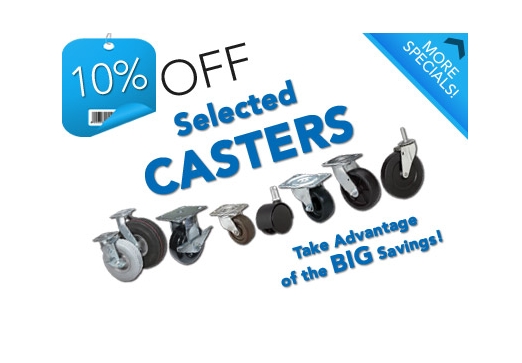 While many people think all casters are the same, in truth there are different types of casters for various jobs. Depending on what your needs are, you may prefer hard rubber casters that provide efficiency and stability in a warehouse setting or you may need softer rubber casters that won’t harm showroom or exhibit hall floors. Buying the right caster for the right job can make all the difference in the world.
While many people think all casters are the same, in truth there are different types of casters for various jobs. Depending on what your needs are, you may prefer hard rubber casters that provide efficiency and stability in a warehouse setting or you may need softer rubber casters that won’t harm showroom or exhibit hall floors. Buying the right caster for the right job can make all the difference in the world.
When selecting the proper caster for a particular piece of equipment, you need to consider a number of different factors, including:
- Productivity
- Safety and Ergonomics
- Floor Protection
- Rollability
- Capacity
- Floor Obstructions and Operating Environment
- Cost/Value
Selecting the Right Replacement Casters
Unless you are building a new piece of specialized equipment, typically what most facilities operators are purchasing are replacement casters. These are bought to take the place of casters that are worn, broken, gone missing or otherwise inoperable. Casters play a critical role in the use of any type of rolling equipment, so if a single caster doesn’t work, the entire unit is often out of commission. While replacement casters can often be purchased directly from the equipment’s manufacturer, you generally have to pay whatever they want to charge you.
A more cost effective plan is to purchase replacement casters from a reputable materials handling company such as Bahrns. That way you can ensure that you are getting precisely the casters you need but at the most affordable and competitive price. When buying casters, it’s a good idea to get a spare part or two so that the next time you experience caster failure, you don’t have to wait for a replacement part to be shipped before putting the piece of equipment back into service.
Different Types of Casters
Caster frames can be either swivel or rigid. Swivel casters have the ability to rotate 360 degrees. Examples include the types of casters found on the bottom of a furniture mover’s dolly or an office chair. Rigid castes are used primarily for straight line travel, so they usually will only roll forward or backward.
The caster itself is held between two “legs”, with one leg on either side of the caster. The wheel of the caster is held in place by a bolt or axle. Above the legs of a swivel caster is a swivel bearing which allows it to turn all the way around. The legs above rigid casters have no swivel bearing.
Always Buy Spare Casters
When buying replacement casters, you typically will buy the entire unit, not just the wheel itself. Most caster assemblies are designed so that they can snap easily into place when they need to be replaced. Always makes sure you purchase the correct size replacement caster or it may not fit into the bottom of the equipment correctly. Check on the caster you are replacing to see if there is a model number or a size before reordering.
Casters are small pieces that can have a big impact on the productivity of your warehouse or facility. By keeping tabs on the state of your casters and purchasing replacement casters before you need them, you can ensure the uninterrupted flow of your productivity.
